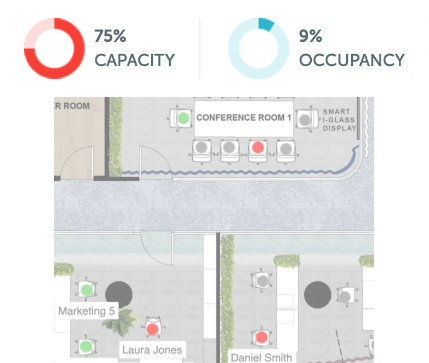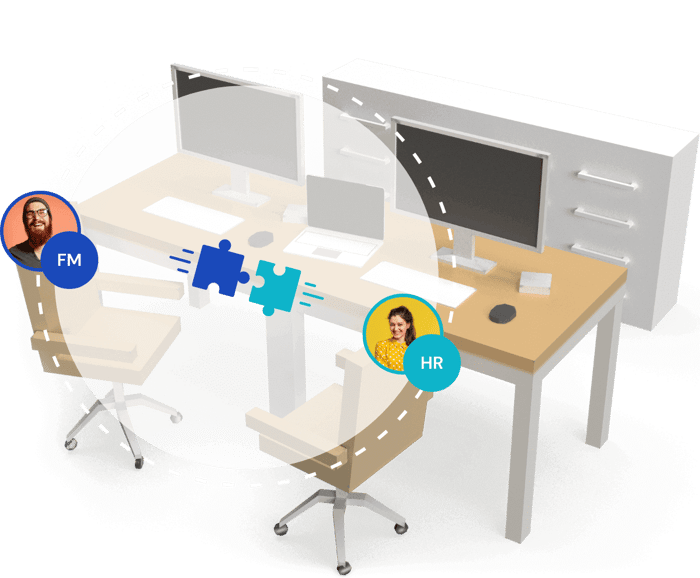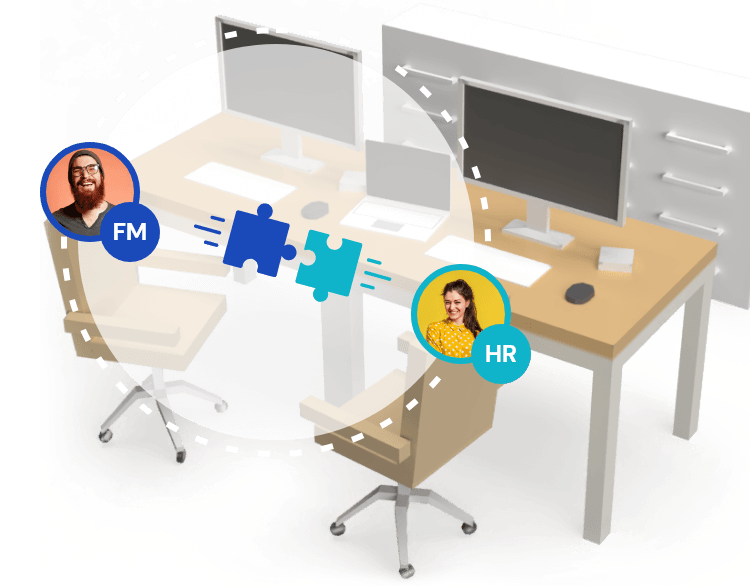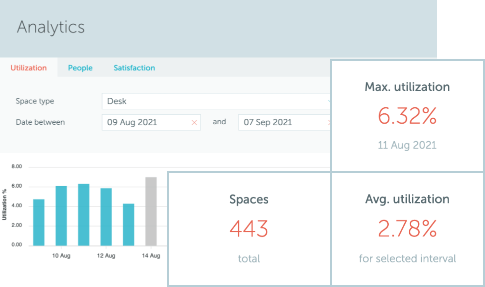
SOLUTIONS
Human Resources & Facility Management collaboration
Leverage culture, environment, and technology to facilitate workplace transformation.


Technology is what
brings culture and
environment on the same page.
Building productive, competitive, and desired hybrid organizations requires breaking down communication barriers within the foundational workplace experience pillars - culture and environment - represented by Human Resources and Facility Management.
Yet sometimes, HR and FM professionals invest time and effort into actions that negatively impact one another. For example, HR might raise work from home quotas while FM struggles to maintain a full-sized office (when, in fact, some of the areas could be temporarily closed, depending on the number of employees onsite).
A shared workplace management platform can help HR and FM departments team up and align their decisions.

Gain control over occupation parameters and get insight on actual reservations.

Define work planning targets and thresholds for your teams.

Share a common understanding of how your spaces are being used.
Insights to get you started
Choosing the right desk booking solution is no small feat. We collected a
couple of insightful resources to help you identify your needs and navigate
the sea of options. Continue your research:
HR and Facility Management: FAQ
Why is HR important in the workplace?
HR, or Human Resources, is a large part of an organization's ability to keep tabs on their employees. They handle everything from hiring and employment termination to workplace benefits and salary.
The organzation as a whole cannot move forward if they neglect HR because without this department, the future of the company becomes uncertain. Without Human Resources making detailed plans for growth and development or managing internal talent pipeline, companies would likely stagnate due to lack of initiative.
What are the tools of Human Resource management?
Human Resource management tools involve:
- Training
- Perks and benefits
- Health insurance
- Annual review
- Performance evaluation
Most of this falls under the title "programs". All but one is a result of a company's HR department, with an annual review being the only thing that doesn't fall completely in their jurisdiction.
How can HR improve collaboration?
There are a few things HR can do to encourage and promote collaboration in the workplace. For starters, they can ensure that the office layout and design encourages people to interact and work together. They can also create policies and procedures that make it easy for employees to collaborate, such as allowing flexible working arrangements, providing adequate communication tools, and establishing clear guidelines for sharing ideas and feedback. And finally, HR can foster a company culture that values teamwork, by celebrating success team-wide, recognizing individual contributions, and promoting a collaborative work environment.
Why is Facility management important in an organization?
Facility management is important in an organization because it encompasses the day-to-day operations and long-term planning of the physical workplace. It includes creating a comfortable and productive environment for employees, as well as managing resources efficiently.
Some of the key benefits of good Facility management include reducing expenses, improving communication, maximizing space utilization, and enhancing employee productivity. By ensuring that all areas of the workplace are functioning effectively, facility managers can play a crucial role in creating a pleasant workplace experience.
What are Facility management techniques?
Facility management techniques are all the methods and strategies used to manage and operate a facility. This includes everything from maintaining the property and equipment, to handling finances and personnel.
There are a variety of different techniques that can be used, depending on the size and type of facility. Some of the most common include budgeting, planning, scheduling, organizing, staffing, and training. It's important to have a strong understanding of all these aspects if you want to run a successful facility.
What is the future of Facility management?
The future of facility management is constantly evolving and changing. With the rise of new technology, there are new opportunities for Facility managers to make their jobs easier and more efficient.
With more and more businesses moving towards using smart buildings, it is important for those in the field of Facility management to stay up-to-date with all the latest trends and technologies.
How Facility management and HR can work together?
Facility managers and HR professionals should be able to work together and cooperate on employee benefits, employee safety, and ensuring that “returning to work” in a post-COVID-19 era is done by putting flexibility at the core of all their initiatives. While the job of a Facility manager and that of an HR manager might seem distant, full collaboration is necessary to ensure a productive, satisfying, and safe workspace for all employees.








